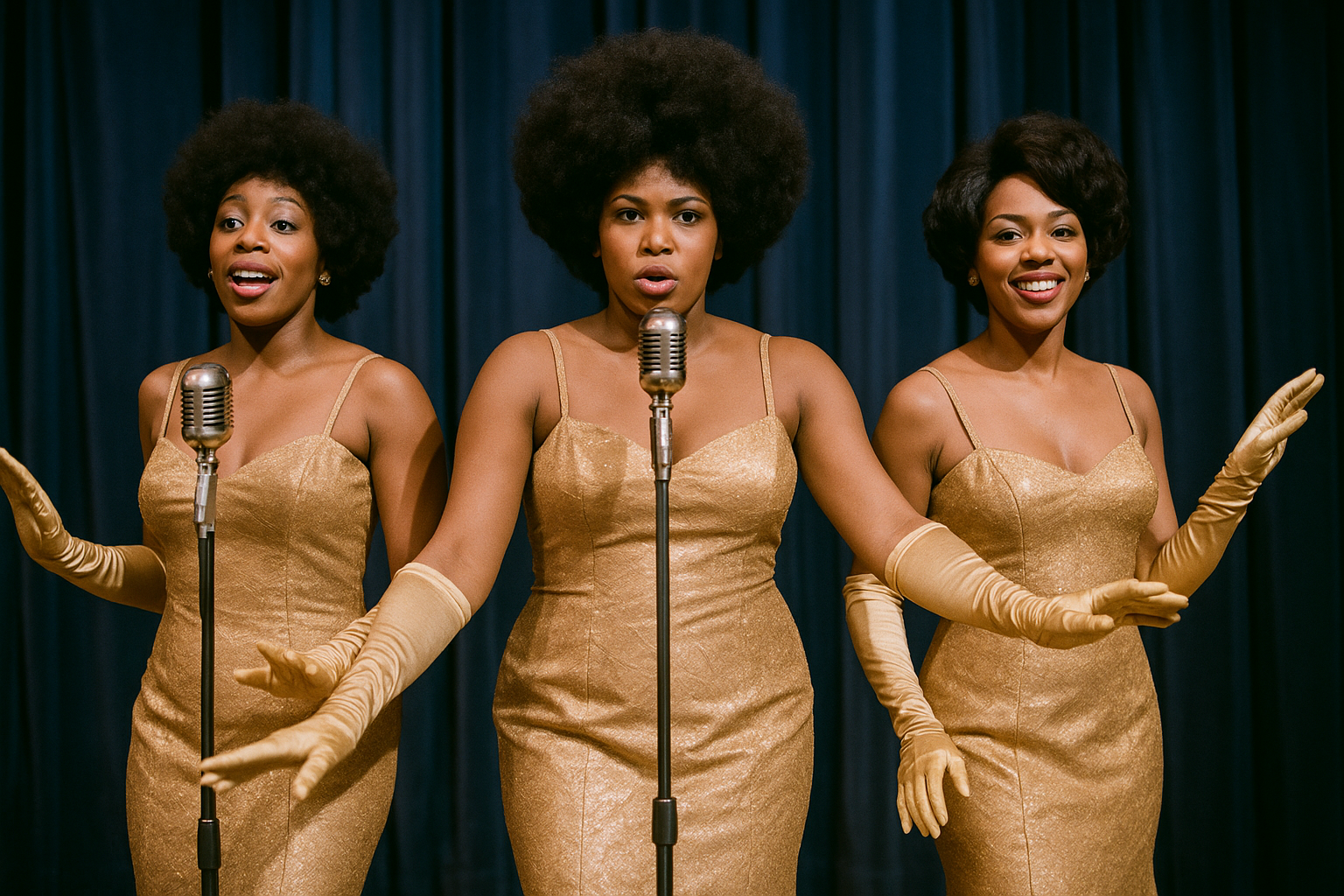Musical Spotlight: Dreamgirls
By Broadwaytrax Content Studio · November 8, 2025
Updated November 10, 2025
Lights dim. Three young women step to the microphones. Their voices blend on one word: move. From that first push, Dreamgirls gathers speed. This show tells a story about talent, friendship, and the price of a dream. It also changed who gets to stand in Broadway's brightest light. Unlike recent spotlights on baseball and 1980s romance, this one focuses on culture and history. Dreamgirls puts Black women's ambition, sound, and story at center stage, and that choice still affects how we cast, sing, and teach.
Dreamgirls is inspired by the 1960s girl-group era and the rise of a polished R&B-to-pop sound. In Chicago, Effie White, Deena Jones, and Lorrell Robinson call themselves the Dreamettes. They sing at an amateur night and catch the eye of Curtis Taylor Jr., a smooth-talking manager. Curtis pairs them with R&B star Jimmy "Thunder" Early, then pushes the trio into a new look and name: The Dreams. Their rise is fast. The sound gets smoother. The clothes sparkle. But the pressure to cross into the pop charts comes with a cost (Encyclopaedia Britannica).
Bring "Dreamgirls" to life with custom tracks
Get the exact arrangement you need—either customize an existing accompaniment or commission a bespoke build from our team.
Don't see this show in our library yet? We'll build it for you.Effie's voice is big and raw, but Curtis wants control, making Deena the lead. Effie resists but is pushed out. Act II shows the consequences. Effie fights for her own career and her child. Jimmy rebels against a fake image. Deena sees how fame can erase a person’s power. By the end, secrets break open. There is apology and some healing, but the show does not pretend everything can be fixed. It ends with respect, family, and a new type of ownership of sound.
The creative team built a landmark. Book and lyrics are by Tom Eyen. Music is by Henry Krieger. Michael Bennett directed and staged the original production, working with choreographer Michael Peters. The design team included Robin Wagner's sleek scenery and Tharon Musser's groundbreaking lighting, making the stage feel like a concert and a film at once (Encyclopaedia Britannica). Dreamgirls opened on Broadway and ran for four years, earning 13 Tony Award nominations and winning 6, marking its status as a premier hit of the season (The Tony Awards).
The score blends gospel fire, R&B groove, and theater storytelling. “And I Am Telling You I’m Not Going” is Effie’s breaking point, a powerful anthem filled with pain and pride. “I Am Changing” shows growth, softer but just as brave. “Dreamgirls” and “Move” mark the group’s rise, with harmonies that feel like a machine kicking into gear. “Steppin’ to the Bad Side” reveals the deals behind the curtain. “Family” gives heart to the company. “One Night Only” highlights how image and gimmicks can erase a singer’s voice, even while it sells records. These songs resonate because the stakes are clear.
The staging felt new. Bennett used mobile light towers and sliding units so scenes flowed like cuts in a film. A club became a studio, then a TV set, with almost no pauses. That fast pace made the music industry feel urgent. Many modern productions echo this look with LED columns, tracked wagons, and concert-style cueing. If you are staging without full towers, keep transitions musical. Let the band carry you from scene to scene because silence breaks the spell.

Dreamgirls did not stop at Broadway. A retooled U.S. tour launched from Harlem’s Apollo Theater in 2009 with a refreshed design. The West End premiere arrived at the Savoy Theatre in 2016, proving the story’s international reach. The film adaptation in 2006 reached even wider audiences, earning eight Academy Award nominations and winning two, including Best Supporting Actress for Jennifer Hudson. This success put the score back on the radio and pulled a new generation to the stage door (The Academy of Motion Picture Arts and Sciences).
Culturally, Dreamgirls is a turning point. It put a trio of Black women at the heart of a big-budget Broadway musical and asked hard questions about image, crossover pressure, and control. It showed that R&B and gospel music belong in the canon, as leading voices. The show also shaped audition rooms. Students study Effie's journey to learn stamina and truth-telling. They use Lorrell's scenes to sharpen comic timing and a quick mix. Curtis and Jimmy teach swagger and phrasing.
For schools, regionals, and tours, care is vital. Effie is a marathon role; build a schedule with covers or alternates, vocal rest, and warm-downs. Invite Black vocal coaches and music directors who are familiar with this style. Keep the rhythm section tight, with drums and bass locking in, and brass shining through. Do not flatten the groove. In design, honor 1960s–70s hair, wigs, and costumes with skilled artists. Avoid stereotypes. Use program notes to explain payola, radio segregation, and crossover marketing so young audiences understand the stakes.
Bring the Dreamettes’ sound to your stage. Get the full
Download the AlbumIf you are new to the score, start with Effie’s two pivotal songs. Hear the fight in “And I Am Telling You,” then the growth in “I Am Changing.” Follow with “Dreamgirls” to catch the shine, and “Steppin’ to the Bad Side” to feel the edge. When you reach “One Night Only,” notice how choices change what the public hears and who gets credit. That is the heart of Dreamgirls: the sound is exciting, and the story asks who owns it.
Dreamgirls shines because it entertains and tells the truth. It celebrates friendship and highlights unfair systems. It lifts up a sound that shaped America and proclaims, this belongs here. That message was brave when it opened, and it still resonates on stages today.
Dreamgirls put Black women’s sound and ambition at the center of a Broadway blockbuster, and that choice still shapes stages today.